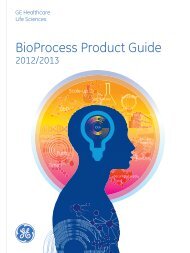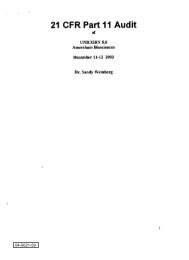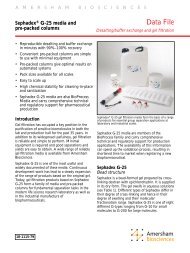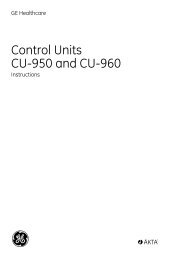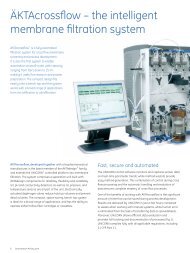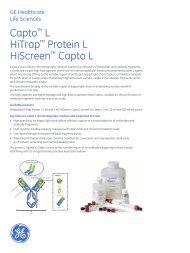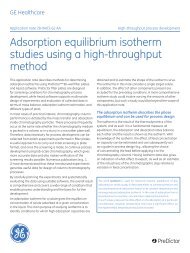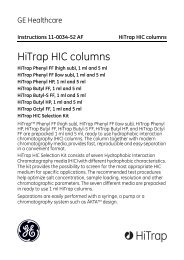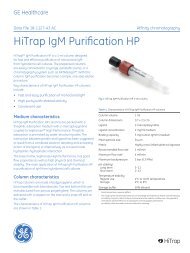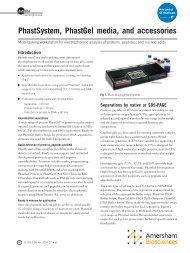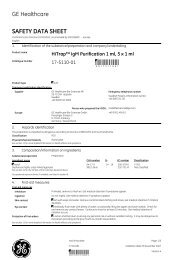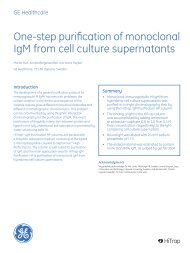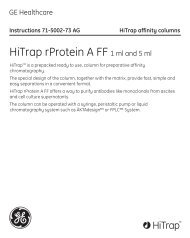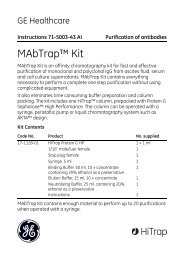HisTrap HP, 1 ml and 5 ml - GE Healthcare Life Sciences
HisTrap HP, 1 ml and 5 ml - GE Healthcare Life Sciences
HisTrap HP, 1 ml and 5 ml - GE Healthcare Life Sciences
Create successful ePaper yourself
Turn your PDF publications into a flip-book with our unique Google optimized e-Paper software.
not always possible to predict which metal ion will be best for a<br />
given protein. The strength of binding between a protein <strong>and</strong> a<br />
metal ion is affected by several factors, including the length,<br />
position, <strong>and</strong> exposure of the affinity tag on the protein, the type of<br />
ion used, <strong>and</strong> the pH of buffers, so some proteins may be easier to<br />
purify with ions other than Ni 2+ .<br />
A quick <strong>and</strong> efficient way to test this possibility <strong>and</strong> optimize<br />
separation conditions is to use HiTrap IMAC <strong>HP</strong> 1 <strong>ml</strong> columns,<br />
which are packed with IMAC Sepharose High Performance (not<br />
charged with metal ions). Each column can be charged with<br />
different metal ions, for example Cu 2+, Co 2+, Zn 2+, Ca 2+, or Fe 2+.<br />
Instructions are included with each column.<br />
A study to compare the purification of six (histidine)6-tagged<br />
recombinant proteins, including three variants of maltose-binding<br />
protein, with different metal ions has indicated that Ni 2+ generally<br />
gives best selectivity between (histidine)-tagged <strong>and</strong> nontagged<br />
host-cell proteins (see Application Note 18-1145-18).<br />
5 Stripping <strong>and</strong> recharging<br />
Note: The column does not have to be stripped <strong>and</strong> recharged<br />
between each purification if the same protein is going to be<br />
purified; it is sufficient to strip <strong>and</strong> recharge it after 5–7<br />
purifications, depending on the cell extract, extract volume,<br />
target protein, etc.<br />
Recommended stripping buffer: 20 mM sodium phosphate,<br />
0.5 M NaCl, 50 mM EDTA, pH 7.4<br />
Strip the column by washing with at least 5–10 column volumes of<br />
stripping buffer. Wash with at least 5–10 column volumes of<br />
binding buffer <strong>and</strong> 5–10 column volumes of distilled water before<br />
recharging the column.<br />
Recharge the water-washed column by loading 0.5 <strong>ml</strong> or 2.5 <strong>ml</strong> of<br />
0.1 M NiSO4 in distilled water on <strong>HisTrap</strong> <strong>HP</strong> 1 <strong>ml</strong> <strong>and</strong> 5 <strong>ml</strong> column,<br />
respectively. Salts of other metals, chlorides, or sulfates, may also<br />
be used (see “Optimization”). Wash with 5 column volumes distilled<br />
water, <strong>and</strong> 5 column volumes binding buffer (to adjust pH) before<br />
storage in 20% ethanol.<br />
12 71-5027-68 AH



